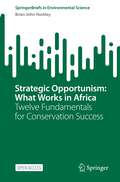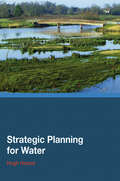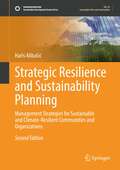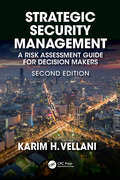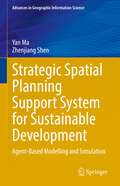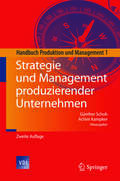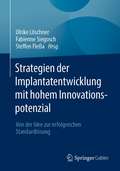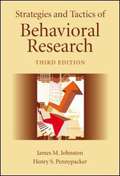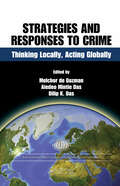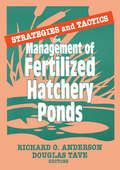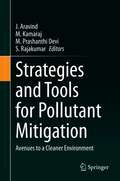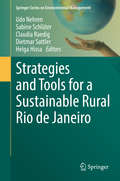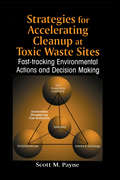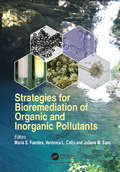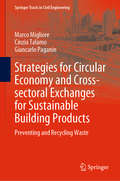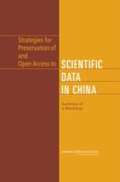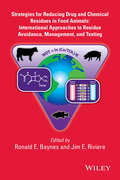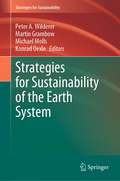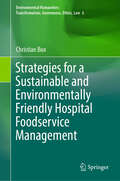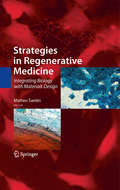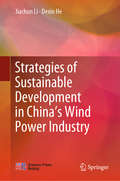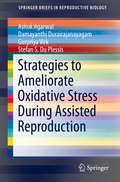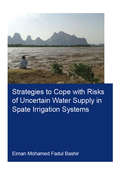- Table View
- List View
Strategic Opportunism: Twelve Fundamentals for Conservation Success (SpringerBriefs in Environmental Science)
by Brian John HuntleyThis open access book. provides a synthesis of six projects, across ten countries, each of which have been sustained for two or more decades, and which illustrate how success can be achieved regardless of systems of governance, of a nation’s wealth, or of culture. Detailed narratives are presented on the key personalities that have conceived, conducted and concluded long-term projects: personal stories of vision, failure, frustration and persistence ultimately leading to success.The case studies vary widely in their geography and goals. The single-handed commitment to re-discover the last surviving populations of Giant Sable in the miombo woodlands of central Angola, through the capture, translocation and establishment of robust breeding herds of this magnificent antelope, contrasts with the massively funded, three-decade programme with over one hundred participants that reversed the annual loss to predation by feral cats of 455 000 seabirds from a sub-Antarctic island. Similarly, the foresight of Zimbabwean and Namibian ecologists to place rural communities at the centre of conservation programmes by giving value to wildlife populations and benefits to local people, transformed a land degradation problem to a socio-ecological solution. Across ten countries, building capacity in botanical collection, documentation and herbarium management expanded into a global project to place the knowledge base of Africa’s flora onto an electronic data system accessible to researchers and conservation planners in even the most remote corners of the continent. None of these projects enjoyed immediate results. Each required leadership skills that combined vision, a generosity of spirit, fortuitous timing and the exploitation of unexpected opportunities.
Strategic Planning for Water
by Hugh HowesStrategic Planning for Water examines the neglected relationship between planning for water and spatial planning. It provides the background to sustainable water management and assistance to spatial planners in understanding the complex water environment. This extremely topical book examines the challenges of:how to ensure that water supplies are a
Strategic Resilience and Sustainability Planning: Management Strategies for Sustainable and Climate-Resilient Communities and Organizations (Sustainable Development Goals Series)
by Haris AlibašićThe book examines management strategies for developing and implementing strategic resilience and sustainability plans for sustainable and climate-resilient communities and organizations. It examines trends in resilience and sustainability planning, highlighting best practices and case studies. The book explores Quadruple Bottom Line strategies and methods to implement resilience and sustainability-related initiatives in organizations and communities. It also examines diverse perspectives on climate resilience, climate preparedness and readiness, greenhouse gas emission reductions policies, climate adaptation and mitigation, disaster preparedness and readiness, and sustainable energy policies and projects. Additionally, the book offers insights on strategic resilience and sustainability planning during a pandemic as well as private sector perspectives on strategic resilience and sustainability. In chapter one, the author presents expanded definitions of strategic resilience and sustainability as well as mechanisms reshaping communities and organizations. Chapter two examines strategic planning processes for communities and organizations and lays out planning steps. Chapter three offers insights into community and organizational level engagement, looking at internal and external stakeholders, organizers, partners, collaborators, and implementers of distinct stages of strategic resilience and sustainability planning. Chapter four outlines measurements and tactics to track and improve strategic resilience and sustainability reporting mechanisms using the quadruple bottom line strategy. It offers a resilience progress report to ensure accountability, answerability, transparency, and good governance. Chapter five details the implementation of a strategic resilience and sustainability plan, describing programs and initiatives to achieve resilient and sustainable communities and organizations. Chapter six extensively examines the theoretical and practical intersection between climate change, resilience, and sustainability. Chapter seven reviews resources available for strategic resilience and sustainability plans to aid communities and organizations. Chapter eight assesses the current and future state of resilience and sustainability in communities and organizations, including concerns surrounding climate change, pandemics, disaster resilience, and emergency management and preparedness.
Strategic Security Management: A Risk Assessment Guide for Decision Makers, Second Edition
by Karim VellaniStrategic Security Management, Second Edition provides security leadership and decision-makers with a fresh perspective on threat, vulnerability, and risk assessment. The book offers a framework to look at applying security analysis and theory into practice for effective security program, implementation, management and evaluation. Chapters examine metric-based security resource allocation of countermeasures, including security procedures, utilization of personnel, and electronic measures. The new edition is fully updated to reflect the latest industry best-practices and includes contributions from security industry leaders—based on their years of professional experience—including: Nick Vellani, Michael Silva, Kenneth Wheatley, Robert Emery, Michael Haggard. Strategic Security Management, Second Edition will be a welcome addition to the security literature for all security professionals, security managers, and criminal justice students interested in understanding foundational security principles and their application.
Strategic Spatial Planning Support System for Sustainable Development: Agent-Based Modelling and Simulation (Advances in Geographic Information Science)
by Zhenjiang Shen Yan MaThis book introduces a planning support system called Strategic Spatial Plan Support System (SSP-SS) to visualize population growth and predict energy demand, land use, and waste discharge resulting from urbanization. By analyzing policy interactions between household agents, the book uses SSP-SS to visualize policy effects on urban areas during stages of growth and decline. Simulations are created based on these policy outcome assessments, taking into account the influences of energy and resource consumption on sustainable development in urban environments. The book is geared towards researchers, universities, and urban policy makers.The book begins by presenting a framework of urban growth simulation, and introducing SSP-SS. Then, household lifecycle and relocation models are employed for simulating policy impacts on urbanization, and investigating the impacts of spatial strategic planning. Several projects are assessed using agent-based modeling including shopping centre construction, day-care service for aging populations, and shelter accommodation capacities for earthquakes and other disasters. The final chapters discuss water and energy management, the environmental impacts of demand and consumption, and future recommendations for sustainable development and policy implementation.Introduces Strategic Spatial Plan Support System (SSP-SS) to visualize population growth and predict energy demand, land use, and waste discharge resulting from urbanization.Analyzes policy effects on urban areas during stages of growth and decline.Discusses the influences of water and gas consumption on environmental issues in urban areas for sustainable development.
Strategie und Management produzierender Unternehmen
by Günther Schuh Achim KampkerProduzierende Unternehmen stehen heute in einem Spannungsfeld, das von unterschiedlichen Anspruchsgruppen und einer hohen wirtschaftlichen Dynamik geprägt ist. Daher ist es wichtig, Entscheidungen unter Berücksichtigung aller relevanten Aspekte schnell und sicher zu treffen. Das Nachschlagewerk bietet einen Überblick über relevante Ansätze und damit die Grundlage, um daraus abgeleitete Methoden anzuwenden. Führungskräfte bekommen ein Instrumentarium an die Hand, das es ihnen ermöglicht, ihre Organisationseinheit effektiv und effizient zu steuern.
Strategien der Implantatentwicklung mit hohem Innovationspotenzial: Von der Idee zur erfolgreichen Standardlösung
by Steffen Fleßa Ulrike Löschner Fabienne SiegoschEine hervorragende Technologie garantiert noch nicht, dass sie sich als Standard durchsetzt. Die Entwicklung innovativer Implantate bildet einen hochkomplexen Prozess, der insbesondere aufgrund seines hohen finanziellen Risikos und seiner zahlreichen Barrieren von Beginn an ein systematisches Management erfordert. Dieses Buch präsentiert eine übersichtliche Zusammenfassung des Implantatentwicklungsprozesses von der initialen Produktidee bis zur Standardlösung einschließlich der wichtigsten Elemente, Barrieren und Strategien. Ein besonderer Fokus liegt dabei auf der Zusammenführung ökonomischer, demografischer und medizinischer Perspektiven. Es bietet eine Art Handlungsleitfaden und dient daher als praxisorientierte Unterstützung für Ökonomen, Mediziner und Ingenieure aus den Bereichen Forschung und Implantatentwicklung.
Strategies And Tactics Of Behavioral Research
by James M. Johnston Henry S. PennypackerThis edition features much more discussion of how research methods are relevant for practitioners, and many examples are based on field research and service delivery scenarios. This comprehensive treatment of single-subject or within-subject design focuses on the strategic (the overall goal) and tactical (the methods and procedures) options available to investigators as they try to determine the most effective way of addressing research questions. The authors guide readers to consider the rationale for different ways of measuring behavior and designing experimental comparisons. At every point, the text explains the strengths and weaknesses of alternative choices so that readers can make the best decision in each situation.
Strategies and Priorities for Information Technology at the Centers for Medicare and Medicaid Services
by Committee on Future Information Architectures Processes Strategies for the Centers for Medicare Medicaid ServicesThe Centers for Medicare and Medicaid Services (CMS) is the agency in the Department of Health and Human Services responsible for providing health coverage for seniors and people with disabilities, for limited-income individuals and families, and for children--totaling almost 100 million beneficiaries. The agency's core mission was established more than four decades ago with a mandate to focus on the prompt payment of claims, which now total more than 1.2 billion annually. With CMS's mission expanding from its original focus on prompt claims payment come new requirements for the agency's information technology (IT) systems. <p><p> Strategies and Priorities for Information Technology at the Centers for Medicare and Medicaid Services reviews CMS plans for its IT capabilities in light of these challenges and to make recommendations to CMS on how its business processes, practices, and information systems can best be developed to meet today's and tomorrow's demands. The report's recommendations and conclusions offered cluster around the following themes: (1) the need for a comprehensive strategic technology plan; (2) the application of an appropriate metamethodology to guide an iterative, incremental, and phased transition of business and information systems; (3) the criticality of IT to high-level strategic planning and its implications for CMS's internal organization and culture; and (4) the increasing importance of data and analytical efforts to stakeholders inside and outside CMS. Given the complexity of CMS's IT systems, there will be no simple solution. <p><p> Although external contractors and advisory organizations will play important roles, CMS needs to assert well-informed technical and strategic leadership. The report argues that the only way for CMS to succeed in these efforts is for the agency, with its stakeholders and Congress, to recognize resolutely that action must be taken, to begin the needed cultural and organizational transformations, and to develop the appropriate internal expertise to lead the initiative with a comprehensive, incremental, iterative, and integrated approach that effectively and strategically integrates business requirements and IT capabilities.
Strategies and Responses to Crime: Thinking Locally, Acting Globally (International Police Executive Symposium Co-Publications)
by Dilip K. Das Aiedeo Mintie Das Melchor De GuzmanEvery year, esteemed scholars and practitioners meet at the International Police Executive Symposium to discuss contemporary issues in policing and share ideas about effective strategies in their jurisdictions. Drawn from the proceedings at the Thirteenth Annual Meeting held in Turkey and updated with new developments since the conference, Strategi
Strategies and Tactics for Management of Fertilized Hatchery Ponds
by Douglas Tave Richard O AndersonYou?ll learn strategies and tactics that can be used to improve production and efficiency in the propagation of fingerlings in fertilized hatchery ponds. This book covers the production of a variety of fish, as well as shrimp, and provides a framework for a systems approach to management decisionmaking. Chapters present information that can be used to improve ecological efficiencies and the economics of production. Strategies and Tactics for Management of Fertilized Hatchery Ponds explains the systems approach to management. In the future, the most effective hatchery managers will base management decisions on information that is site- and pond-specific. This book provides you with needed information on organic and inorganic fertilizer materials; dynamics of water quality; pond filling schedules; biological control of problem organisms; fingerling production of walleye, striped bass, paddlefish, largemouth bass, and others. Readers find solutions to several common problems and learn about the processes needed to solve others.Chapters help answer questions important to the success and effectiveness of management of fertilized hatchery ponds such as: What kinds or sources of nutrients should be purchased? How much time and water are needed before larvae are stocked? What density and age of fish should be stocked? How can a satisfactory quality of larvae and environmental variables be achieved so that fish survive stocking and initiate normal feeding and growth? Has the initial survival and growth been satisfactory, or should the pond be drawn down and restocked? What kind and how much fertilizer should be added to a given pond?This book provides you with information essential for making hatchery ponds as effective and efficient as possible. Whether you?re a fish hatchery manager, student of aquaculture, or agency or academic researcher involved in hatchery management, you will find Strategies and Tactics for Management of Fertilized Hatchery Ponds an indispensable guide for your daily work and studies.
Strategies and Tools for Pollutant Mitigation: Avenues to a Cleaner Environment
by J. Aravind M. Kamaraj M. Prashanthi Devi S. RajakumarThis volume explores recent research trends and achievements in environmental pollution remediation (e.g. water, air, soil), and compiles critical and constructive papers and reviews with a focus on advances in bioremediation and green technology solutions for waste minimization, waste management and pollution control. The book is timely, as the need for researchers and engineers to develop sustainable and green eco-friendly remediation technologies is increasing with a growing global population, stressed agricultural systems, and an environment impacted by climate change. A key focus of the book is on the efficient use of agricultural waste residues as viable substrates for creating materials for environmental clean-up, and the possible conversion of these pollutants to sustainable bioresources. The volume will be of interest to sustainability researchers, environmental engineers, industry managers and agricultural scientists.
Strategies and Tools for Pollutant Mitigation: Research Trends in Developing Nations
by J. Aravind M. Kamaraj S. KarthikeyanThis book offers an overview of the latest work in environmental remediation and waste management coming out of developing nations. It is split into two sections: one on state-of-the-art sustainable remediation approaches, and the other covering waste management for a cleaner environment The ten chapters in this book are structured as reviews that assimilate recent works in these areas; they provide a centralized resource for scholars in developing nations who are working in environmental remediation and waste management. The volume will be of interest to sustainability researchers, environmental engineers, industry managers and agricultural scientists.
Strategies and Tools for a Sustainable Rural Rio de Janeiro (Springer Series On Environmental Management Ser.)
by Udo Nehren Sabine Schlϋter Claudia Raedig Dietmar Sattler Helga HissaThis book is a compilation of recent developments in land, ecosystem, and water management in the Brazilian state of Rio de Janeiro. The state is located in the biodiversity hotspot of the Atlantic Forest (Mata Atlântica), a biome characterized by high biological diversity and endemism. At the same time the state of Rio de Janeiro emerged to one of the economic hubs in Latin America. This development process has been accompanied by population growth, industrialization, urbanization, as well as consumption and degradation of land and water resources. In the past years many efforts have been made to stop or at least slow down these degradation processes and restore degraded environments with the overall goal to bring together sustainable management of natural resources, nature conservation, and economic development. An overview is provided of the different strategies and tools that have been developed in the fields of agriculture, ecosystem management and biodiversity, integrated water management, land restoration, disaster risk reduction and climate change adaptation, as well as environmental governance and economic instruments. This book covers a wide spectrum from applied research to science‐policy interfaces, planning concepts, and technical tools and has a model character for other rural areas in Latin America. Target groups are scientists, practitioners, policy makers and graduate students in the field of environmental management. The different chapters are written by researchers and practitioners of the German‐Brazilian project INTECRAL (Integrated Eco Technologies and Services for a Sustainable Rural Rio de Janeiro), the rural development program Rio Rural under the state secretary for agriculture and animal husbandry, as well as invited scientists from Brazilian universities and research institutes. It bridges existing gaps between science, policies, and practice in rural development.
Strategies for Accelerating Cleanup at Toxic Waste Sites: Fast-Tracking Environmental Actions and Decision Making
by Scott Marshall PayneAccelerating Cleanup at Toxic Waste Sites: Fast-tracking Environmental Actions and Decision Making presents truly innovative advances in investigative and cleanup technologies, offering valuable solutions that streamline the data collection process, speed up the time it takes to characterize a site, and expedite decision making.Using easy to understand graphic displays, tables, text summaries, and real world case studies, and by synthesizing technical and regulatory reference information crucial to the development of effective cleanup strategies, this book provides the framework for environmental professionals to develop project and program approaches that meet today's needs.An advanced text for those with at least basic understanding of environmental investigation, cleanup, regulations, decision making, and policy development, Accelerating Cleanup at Toxic Waste Sites addresses the "human" side of the environmental industry and why it is perhaps one of the most important considerations for successful accelerated cleanup. This book takes the next step by providing managers, project teams, and other professionals with approaches that bring techniques, regulations, strategies, and people together into one comprehensive package that works.
Strategies for Bioremediation of Organic and Inorganic Pollutants
by Maria S. Fuentes Verónica L. Colin Juliana M. SaezIncreased awareness surrounding environmental protection has prompted the development of more ecofriendly technologies. This book provides useful information on technologies based upon the use of biological agents for environmental clean-up, including bacteria, yeast, fungi, algae, and plants. Some chapters refer to the direct application of products derived from plants and microorganisms for designing strategies of environmental remediation. The combination of strategies helps in efficient removal of pollutants generated from anthropogenic activities with minimal environmental impact. This book is meant for professionals involved in environmental technology and waste management.
Strategies for Circular Economy and Cross-sectoral Exchanges for Sustainable Building Products: Preventing and Recycling Waste (Springer Tracts in Civil Engineering)
by Cinzia Talamo Marco Migliore Giancarlo PaganinThis book offers a valuable tool for understanding current efforts to promote the reuse and enhancement of pre-consumer waste in the development of new products for the construction sector, as well as the financial and regulatory tools being used to support this trend. It explores the vast and complex topic of the circular economy from the perspective of strategies for the reuse/recycling of waste, and develops a number of key premises: waste reuse/recycling must be considered using a logic of cross-sectoriality, recognizing the need to enhance the “dialogue” between different sectors; pre-consumer waste is particularly interesting for the recycling market because the construction sector can reduce its environmental impacts by enhancing its capacity to use secondary raw materials and by-products from other sectors; and lastly, the manufacturing sector is currently experimenting with promising forms of reducing/recycling pre-consumer waste and is at the same time providing by-products that can be used in other production chains. As such, the book offers a valuable asset for professionals who are interested in sustainability in construction, and in the study of construction products; however, it will be equally useful for local decision-makers tasked with implementing development policies and innovations in the industrial sector.
Strategies for Preservation of and Open Access to SCIENTIFIC DATA IN CHINA: Summary of a Workshop
by National Research Council of the National AcademiesPreservation of and open access to digital scientific resources are essential to global research, yet the challenges in storing and maintaining access to these collections are substantial. China faces major hurdles in this regard. A workshop held in June 2004 in Beijing convened scientific information managers, digital archiving experts, national science policy and funding officials, and representatives of development organizations to explore the scientific and technical, legal and policy, institutional and economic, and management aspects of creating sustainable and accessible archives of digital health and environmental data in China.
Strategies for Reducing Drug and Chemical Residues in Food Animals
by Jim E. Riviere Ronald E. BaynesHighlighting international approaches; the book details strategies to minimize contamination, residue monitoring programs, and classes of drugs and chemicals that pose contaminant risk in livestock. Focuses attention on drug and chemical residues in edible animal products Covers novel computational, statistical, and mathematical strategies for dealing with chemical exposures in food animals Details major drug classes used in food animal production and their residue risks Highlights efforts at harmonizing and the differences among areas like US, EU, Canada, Australia, South America, China, and Asia, where the issue of chemical exposures has significant impact on livestock products Ties veterinary clinical practice and the use of these drugs in food animals with regulatory standards and mitigation practices
Strategies for Sustainability of the Earth System (Strategies for Sustainability)
by Peter A. Wilderer Martin Grambow Michael Molls Konrad OexleThis volume builds on an international workshop held in 2019, inspired by James Lovelock's "The Revenge of Gaia - Why the Earth Is Fighting Back, and How We Can Still Save Humanity". It, therefore, understands the Gaia concept as an umbrella term for the living world that planet Earth is hosting for nearly 4 billion years. Humankind has intervened in this ecosystem since its emergence on the planet about 2.5 million years ago, often with painful consequences for itself. In its reactions, the Earth system follows only the laws of nature. Consequently, humanity needs to develop strategies for a sustainable Earth system. This volume presents a unique trans- and interdisciplinary variety of approaches to this challenge, offering philosophical considerations as well as practical medical research. It addresses a broad knowledgeable and general audience in environmental management, public administration, and higher education alike.
Strategies for a Sustainable and Environmentally Friendly Hospital Foodservice Management (Environmental Humanities: Transformation, Governance, Ethics, Law #6)
by Christian BuxSustainable catering aspires to reduce the environmental impacts of foodservice by serving nutritional, safe and environmentally friendly meals, and Italy has embraced the adoption of environmentally friendly diets and the minimization of food waste by introducing the minimum environmental criteria. However, there may be some tension between these two actions as environmentally friendly diets may lead to greater waste. The present book, in the field of the research projects entitled “Monitoring agri-food resilience and environmental savings in Puglia” and “Green supply chain management in the hospital catering service”, has the overarching purpose to improve the understanding of environmental, economic and social sustainability of foodservice, by considering the significant variables of energy efficiency, environmental impacts, waste management, customer satisfaction and user nutrition. The book reports the findings of different studies conducted in the hospital foodservice.
Strategies in Regenerative Medicine
by Matteo SantinThis authoritative book offers a detailed overview of present and future tissue engineering approaches and their contribution to regenerative medicine. It combines comprehensive reviews of the biology and materials science underlying the development and regeneration of different types of tissues with descriptions of current and future strategies in regenerative medicine to meet clinical needs. Each chapter includes typical examples of methodologies and technical solutions as the basis for the most recent scientific findings and biomedical products, tables as mini-databases summarizing the most recent findings, and links to specific websites in the main body of the text to complement a traditional reference list. Strategies in Regenerative Medicine: Integrating Biology with Materials Design covers topics from basic biology and materials science to the link between biological processes in tissue regeneration and biomedical device/tissue engineering product performance. Key Features: (1) Provides a comprehensive overview of regenerative medicine in the framework of clinical and industrial needs; (2) Describes the use of biomaterials and tissue engineering constructs in clinical applications; (3) Presents the work of international experts according to consistent, well-defined editorial guidelines; (4) Reviews the underlying biology of tissue regeneration; (5) Includes student exercises, references to relevant websites, and perspectives on future research needs, making the book ideal for use as a teaching text.
Strategies of Sustainable Development in China’s Wind Power Industry
by Jiachun Li Dexin HeThis book reviews the status quo and visions for the future in the wind energy industry in China and around the globe, focusing on its roles in optimizing energy structure, alleviating environmental pollution, and coping with climate change. Providing a blueprint of wind power development till 2050, it suggests a series of further measures in the context of policies, regulations, laws, and marketing in order to overcome the existing bottlenecks. Moreover, it proposes a number of potential innovative technologies related to IT+ and advanced manufacturing, including integrated & distributed power and micro-grid systems, multi-energy complement, green and intelligent manufacturing, reliability design, blade design, manufacturing and maintenance, drive drain systems, and offshore wind farms. This book offers researchers and engineers insights into sustainable development in the wind power industry.
Strategies to Ameliorate Oxidative Stress During Assisted Reproduction
by Ashok Agarwal Damayanthi Durairajanayagam Gurpriya Virk Stefan S. Du PlessisThis book discusses the various antioxidants that are in use to overcome oxidative stress in an assisted reproduction setting. Antioxidant therapies may range from enzymatic and non-enzymatic antioxidants, either alone or in combination. While no one antioxidant regime has been identified as effective in improving fertilization and pregnancy rates, antioxidant supplementation has been shown to defend sperm cells from lipid peroxidation and oxidative damage to DNA, and thus improve pregnancy rates. The prevention of oxidative stress and its consequent damage is imperative to ensure a successful outcome of the in vitro fertilization procedure and embryo transfer. Strategies that could be employed to minimize or prevent the detrimental effects of OS during assisted reproduction include supplementation with various types of antioxidants.
Strategies to Cope with Risks of Uncertain Water Supply in Spate Irrigation Systems: Case Study: Gash Agricultural Scheme in Sudan (IHE Delft PhD Thesis Series)
by Eiman Mohamed Fadul BashirFlood based irrigation in particular spate irrigation relies on variable flood scenarios occurring every year. Management of spate flood for spate irrigation must cope with the variability and uncertainty of water supply. Coping with water supply risks is often the only way to harness the opportunities for a productive use of water in arid environment. Integrating and strengthening community responses into irrigation policies and improvement plans could ensure sustainable and productive spate irrigated systems that can achieve food security for the poor population. This research analyses and evaluates risks and coping strategies developed by farming communities in the Gash spate irrigation system in Sudan, Eastern Africa. The research has synthesized different coping strategies developed by farmers, water user associations and water managers to cope with low, high and untimely flood risks. The research provide different frameworks that can assist with the identification of risk sources, pathways and propagation as well as evaluation of locally developed strategies at field, secondary and intake systems. The findings of this study contribute to scarce knowledge on spate irrigation system and provide scientifically sound and evidence-based insights to aid informed policy and decision making to improve productivity and sustainability of the spate irrigation systems.
